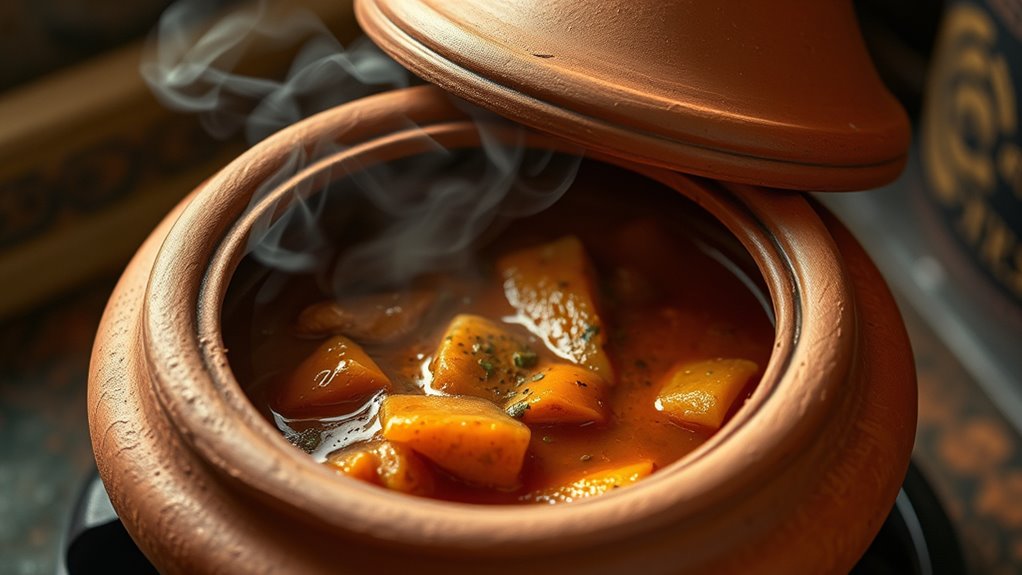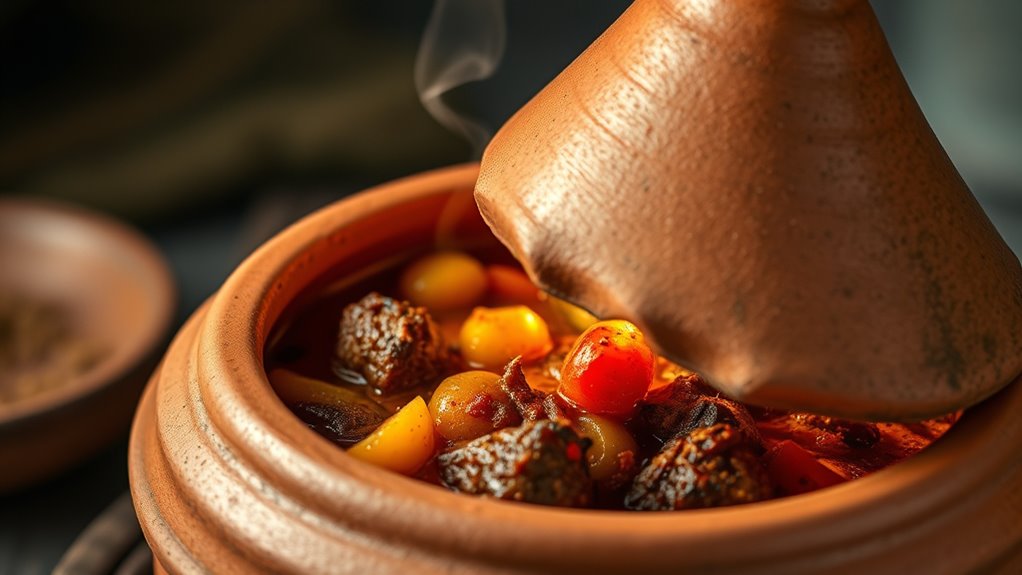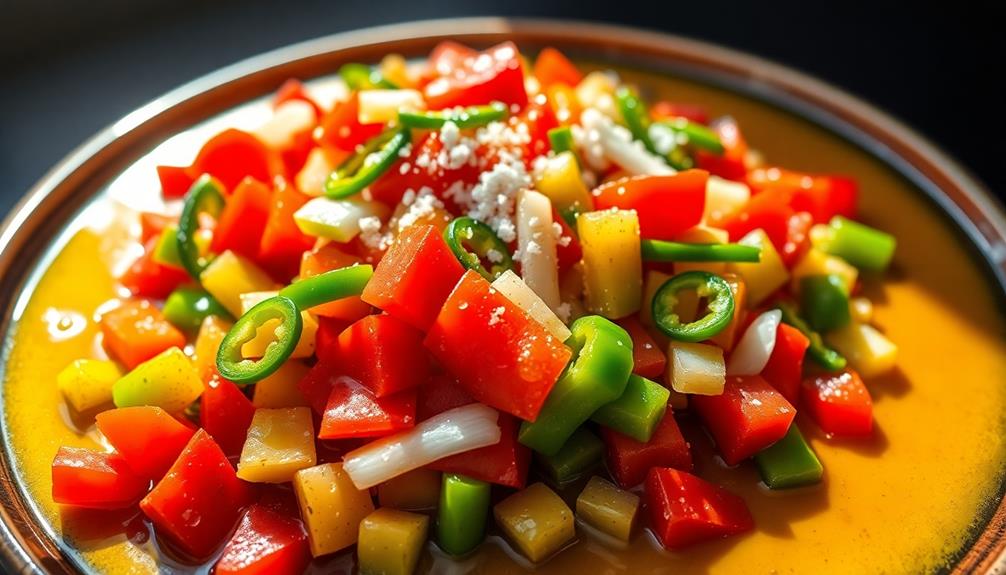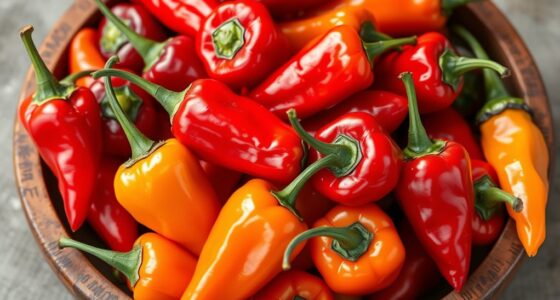To control temperature inside a clay tagine, start with low to medium heat to prevent cracking and scorching. Use a heat diffuser to evenly distribute heat and avoid hot spots. Keep the lid on to trap moisture and regulate temperature naturally. Adjust the heat as needed to maintain gentle simmering, allowing flavors to develop without burning spices or ingredients. Continue exploring to reveal expert tips and techniques for perfecting your Moroccan tagine.
Key Takeaways
- Use low to medium heat to prevent cracking and ensure gentle, even heat distribution inside the clay pot.
- Employ a heat diffuser to avoid direct contact and control temperature spikes during cooking.
- Start with higher heat for searing, then reduce to low for slow simmering to develop flavors.
- Cover the tagine with a conical lid to retain moisture and regulate temperature naturally.
- Monitor and adjust heat regularly to maintain steady cooking conditions and avoid burning spices or ingredients.

A Moroccan tagine is a flavorful, slow-cooked stew that captures the essence of North African cuisine. When you’re preparing a tagine, mastering temperature control inside the clay pot is essential for achieving that tender, aromatic dish everyone loves. The key to that lies in understanding how to use the traditional clay vessel effectively, especially when it comes to spice blending and cooking techniques. The right balance of heat ensures the ingredients meld beautifully, and the spices release their full depth of flavor without burning or overpowering the dish.
First, you need to recognize how heat interacts with the clay material of your tagine. Unlike modern cookware, clay retains and distributes heat slowly and evenly, which is perfect for simmering. However, it also means you must be cautious with temperature control. Start by placing the tagine on a heat diffuser if you’re cooking directly over a stove. This helps prevent direct contact with high heat and avoids cracking or scorching. Low to medium heat is ideal for slow-cooking, allowing the flavors to develop gradually. This controlled environment is indispensable when you’re blending spices—such as cumin, coriander, cinnamon, and paprika—into your dish. These spices need gentle heat to release their oils and aroma, but they can burn easily if the temperature spikes suddenly.
Clay retains heat slowly and evenly, so use low to medium heat and a diffuser for perfect Moroccan tagines.
Cooking techniques play an essential role in maintaining ideal temperature inside a clay pot. When you begin, sear your meat or vegetables at a slightly higher temperature briefly to lock in flavor, then reduce to low. Cover the tagine with its conical lid to trap moisture and create a self-basting environment. This moisture retention is key for tenderizing tougher cuts of meat and infusing the dish with layered flavors. As the cooking progresses, you should monitor the heat and adjust as needed, ensuring it stays steady. Remember, the slow simmer is what transforms simple ingredients into a rich, flavorful stew. Additionally, understanding the heat retention properties of clay can help you better anticipate how your dish will cook over time. Being aware of the clay’s heat distribution capabilities allows for more precise control, preventing hot spots that could scorch your ingredients. Properly managing heat also helps in preventing the spices from burning, which is crucial for maintaining their delicate flavors.
Furthermore, maintaining a consistent temperature throughout the cooking process is crucial for developing complex flavors, and using a heat diffuser can be a helpful tool in achieving this. Spice blending in a tagine isn’t just about adding spices; it’s about creating a harmonious balance that intensifies during cooking. When your heat is well-controlled, the spices meld with the ingredients, releasing their full potential. This is why precise temperature control isn’t just a technical detail—it’s the foundation of good flavor. With patience and attention, your tagine will develop complex layers, showcasing the perfect combination of tender meat, aromatic spices, and succulent vegetables. By mastering both your cooking techniques and temperature management, you’ll consistently craft authentic Moroccan dishes that are bursting with flavor and tradition.
Frequently Asked Questions
Can I Use a Tagine on an Induction Stove?
You might wonder if you can use a tagine on an induction stove. Since induction cooktops require magnetic materials, check if your tagine is made of or has a base compatible with electric induction. If it’s unglazed or made of traditional clay, it probably isn’t heat suitable without a diffusion plate. To guarantee safety and proper cooking, use a magnetic adapter or choose a tagine specifically designed for electric induction stoves.
How Long Should I Preheat a Clay Tagine?
You should preheat a clay tagine for about 15-30 minutes, depending on your stove and recipe. Proper preheating guarantees even heat distribution, preventing cracks and sticking. Before using, season your clay pot to enhance its heat retention and durability. To preheat, start on low heat and gradually increase to medium. This process helps your tagine cook evenly and improves its overall performance.
Is It Safe to Put a Hot Tagine in the Fridge?
Think of your tagine as a delicate sculpture; sudden changes can cause cracks. It’s not safe to put a hot tagine in the fridge, as rapid cooling risks damage and food safety issues. Instead, let it cool to room temperature first. For proper storage tips, transfer leftovers to airtight containers, and refrigerate promptly. This guarantees your dish stays fresh and safe, preserving both the flavor and the integrity of your beautiful clay pot.
How Do I Prevent Food From Sticking to the Tagine?
To prevent food from sticking to your tagine, start by ensuring good moisture retention, which keeps food tender and prevents sticking. While traditional clay tagines don’t have a non-stick coating, you can lightly oil the interior before cooking and avoid high heat. Using enough liquid and stirring gently also helps. Properly seasoned and maintained, your tagine will develop a natural non-stick surface over time, making cooking easier.
What Are the Best Types of Fuel for Outdoor Cooking?
For outdoor cooking, you want reliable fuel options like charcoal grilling and wood fire. Charcoal provides consistent heat and easy control, perfect for most grilling needs. Wood fire adds a smoky flavor and a rustic touch, ideal for slow-cooked dishes or grilling steaks. Both fuels are versatile, but make sure you choose high-quality charcoal or seasoned wood for peak heat and flavor. Always prioritize safety and proper ventilation when using these fuels outdoors.
Conclusion
Mastering temperature control in your Moroccan tagine guarantees tender, flavorful results every time. Did you know that slow cooking at low temperatures can retain up to 85% of nutrients compared to quicker methods? By adjusting your heat carefully, you’ll reveal authentic flavors and achieve that perfect, melt-in-your-mouth texture. So, take your time, monitor your heat, and enjoy the delicious journey of making an authentic Moroccan tagine right in your own kitchen.









